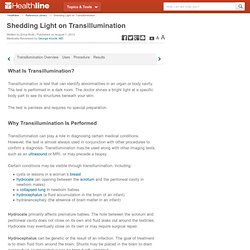

Transillumination: Shining Light on Your Organs. Transillumination is test that can identify abnormalities in an organ or body cavity.

The test is performed in a dark room. The doctor shines a bright light at a specific body part to see its structures beneath your skin. The test is painless and requires no special preparation. Transillumination can play a role in diagnosing certain medical conditions. However, the test is almost always used in conjunction with other procedures to confirm a diagnosis. Certain conditions may be visible through transillumination, including: cysts or lesions in a woman’s breast hydrocele (an opening between the scrotum and the peritoneal cavity in newborn males) a collapsed lung in newborn babies hydrocephalus (a fluid accumulation in the brain of an infant) hydranencephaly (the absence of brain matter in an infant) Hydrocele primarily affects premature babies.
Hydrocephalus can be genetic or the result of an infection. Your doctor will dim the lights in the exam room to perform the transillumination test. Www.cancer.gov/cancertopics/coping/radiation-side-effects/fatigue.pdf. Testicular cancer. The most common cancer seen in testicular cancer survivors is a second testicular cancer.

Overall, 2% to 5% of men who have had cancer in 1 testicle will eventually have it in the other testicle. The second cancer is not from treating the first cancer with radiation or chemotherapy. In fact, those treated with surgery alone still have an increased risk of a second testicular cancer. The chance of getting a second testicular cancer is actually lower in men who were treated with chemotherapy. The rest of this section is about second cancers other than testicular cancer. Risk of solid tumors Compared with most men in the general population, testicular cancer survivors are up to twice as likely to develop a new cancer outside the testicle.
The risk of a solid tumor cancer starts going up within 5 years and doubles after 10 years in those men who were treated with radiation alone. In recent years, radiation therapy for testicular cancer has changed. Risk of leukemia Follow-up care. Pelvic (between the hips) radiation - discharge: MedlinePlus Medical Encyclopedia. When you have radiation treatment for cancer, your body goes through some changes.

About 2 - 3 weeks after your first radiation treatment, you may have these side effects: Your skin over the treated area may turn red, start to peel, get dark, or itch.Your body hair will fall out, but ONLY in the area being treated. When your hair grows back, it may be different than before.You may have bladder discomfort. You may have to urinate often. It may burn when you urinate.You may have diarrhea and cramping in your belly. Woman may have: Itchiness, burning, or dryness in the vaginal areaMenstrual periods that stop or changeHot flashes Both men and women may lose interest in sex. Skin Care When you have radiation treatment, a health care provider draws colored markings on your skin. Take care of the treatment area: Wash gently with lukewarm water only. Tell your doctor or nurse if you have any break or opening in your skin. Do not put heating pads or ice bags on the treatment area. Self-care Intimacy.
Www.cancer.gov/cancertopics/coping/radiation-side-effects/nausea.pdf. Www.cancer.gov/cancertopics/coping/radiation-side-effects/urination.pdf. Www.cancer.gov/cancertopics/coping/radiation-side-effects/skin.pdf.